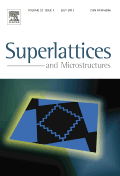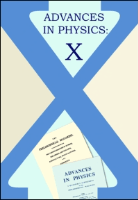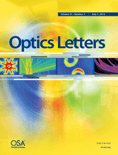
Semiconductor Physics Quantum Electronics & Optoelectronics
Scope & Guideline
Navigating the Quantum Realm of Electronics and Optics
Introduction
Aims and Scopes
- Semiconductor Materials and Structures:
Research on the synthesis, characterization, and optimization of various semiconductor materials, including nanostructures, thin films, and heterojunctions. Studies often focus on the electronic, optical, and structural properties of these materials. - Quantum Electronics:
Exploration of quantum phenomena in electronic devices, including quantum dots, quantum wells, and other low-dimensional systems. This area includes studies on the behavior of charge carriers and excitons under various external influences. - Optoelectronic Devices and Systems:
Development and characterization of optoelectronic devices such as LEDs, lasers, photodetectors, and solar cells. Research includes improving efficiency, stability, and functionality of these devices through innovative materials and designs. - Nanotechnology and Nanomaterials:
Investigation of nanostructured materials and their applications in electronics and optoelectronics. This includes studies on the properties of nanoparticles, nanocomposites, and their integration into devices. - Computational Modeling and Simulation:
Utilization of computational techniques to model semiconductor behavior, device performance, and material properties. This includes numerical simulations and theoretical analyses that support experimental findings. - Environmental and Green Technologies:
Research focused on sustainable practices in semiconductor manufacturing and the development of environmentally friendly materials and processes, particularly in the context of solar energy and organic electronics.
Trending and Emerging
- Nanostructured and Hybrid Materials:
There is an increasing interest in the development of nanostructured materials and hybrid systems that combine different material types to achieve enhanced performance in electronic and optoelectronic applications. - Perovskite-based Technologies:
Research on perovskite materials, particularly in solar cells and LEDs, has surged. This is driven by their remarkable efficiency and the potential for low-cost manufacturing, marking a significant shift in solar energy research. - Machine Learning Applications:
The application of machine learning algorithms in predicting material properties and optimizing device performance is gaining traction. This trend indicates a broader integration of computational techniques in experimental semiconductor research. - Sustainable and Eco-friendly Materials:
Emerging studies on environmentally friendly materials and processes, including green synthesis methods for semiconductor nanoparticles, reflect a growing commitment to sustainability in semiconductor research. - Quantum Computing and Information Technologies:
There is a noticeable increase in research related to quantum computing and quantum information technologies, particularly in the context of semiconductor materials that can be utilized in qubits and quantum networks.
Declining or Waning
- Traditional Bulk Semiconductor Materials:
Research on conventional bulk semiconductor materials has decreased as the focus has shifted towards nanomaterials and advanced structures. This trend indicates a movement towards exploring new materials that offer enhanced properties and functionalities. - Classical Photonic Devices:
Studies on traditional photonic devices, such as basic optical sensors and light sources, are becoming less frequent. The emphasis is now on integrating novel materials and advanced technologies to create more sophisticated and efficient devices. - Conventional Solar Cell Technologies:
Research related to established solar cell technologies, particularly those based on silicon without innovative modifications, appears to be waning. The field is increasingly focusing on emerging technologies like perovskite solar cells and tandem structures. - Basic Theoretical Models:
Publications centered on basic theoretical models without practical applications or experimental validation are declining. There is a growing preference for research that combines theoretical insights with experimental results to address real-world challenges.
Similar Journals

Results in Physics
Advancing Knowledge, Unleashing InnovationResults in Physics, an esteemed open-access journal published by ELSEVIER, has been a prominent platform for disseminating cutting-edge research in the field of physics since its establishment in 2011. With its ISSN 2211-3797 and E-ISSN 2211-3797, this journal proudly holds a Q2 ranking in the Physics and Astronomy category for 2023, showcasing its significance and quality within the scientific community. With a remarkable Scopus rank of #28 out of 243 in the general physics and astronomy domain, placing it within the 88th percentile, Results in Physics serves as a vital resource for researchers, professionals, and students alike, fostering a collaborative environment for the advancement of knowledge across various subfields. The journal aims to provide a rapid and unrestricted access to innovative findings, encouraging open scientific dialogue and enhancing the visibility of breakthrough research. Located in the Netherlands at RADARWEG 29, 1043 NX AMSTERDAM, Results in Physics continues to uphold its commitment to excellence and accessibility in the ever-evolving landscape of physics research.

APL Materials
Exploring breakthroughs in materials research.APL Materials is a prestigious open access journal published by AIP Publishing that has been at the forefront of disseminating cutting-edge research in the fields of materials science and engineering since its inception in 2013. With an impressive impact factor reflecting its significance, APL Materials ranks securely in the Q1 quartile in both Engineering (miscellaneous) and Materials Science (miscellaneous) categories, underscoring its role as a vital resource for innovative scientific inquiry. Ranked highly in Scopus, particularly in General Engineering (24/307) and General Materials Science (78/463), the journal provides a platform for researchers, professionals, and students to share their findings and advancements that push the boundaries of material applications. Furthermore, its open access policy ensures that high-quality research is freely available to a global audience, fostering collaborative advancements in the scientific community. As the journal continues to evolve through to 2024, it remains committed to presenting groundbreaking studies that contribute to the advancement of materials science and engineering disciplines.Explore APL Materials to stay at the cutting edge of research and innovation.

Journal of Ovonic Research
Catalyzing Innovations in Surface and Coating Technologies.Journal of Ovonic Research is a distinguished publication dedicated to advancing the fields of electronic, optical, and magnetic materials. Published by VIRTUAL CO PHYSICS SRL, this journal offers a platform for researchers to share innovative findings and developments that push the boundaries of technology and materials science. With an ISSN of 1842-2403 and an E-ISSN of 1584-9953, it provides an important service to the academic community, particularly within Romania and beyond. Despite its recent inception in 2011, the journal has gained traction in the academic landscape, reflecting a Q4 quartile ranking in crucial categories such as Electronic, Optical and Magnetic Materials, as well as in Physics and Astronomy. The Scopus rankings further underscore its positioning, ranking within the 25th to 37th percentile across various disciplines, making it a valuable resource for professionals and students alike. Although the journal currently operates on a non-open access basis, it remains committed to exploring the latest advancements in materials science, encouraging interdisciplinary collaboration and fostering a deeper understanding of surface, coating, and film technologies. As the field evolves, Journal of Ovonic Research stands as a beacon for scholarly communication, bridging the gap between research and practical application.

SUPERLATTICES AND MICROSTRUCTURES
Unveiling the potential of microstructured materials.SUPERLATTICES AND MICROSTRUCTURES is a premier journal dedicated to the exploration and dissemination of cutting-edge research in the fields of Condensed Matter Physics, Electrical and Electronic Engineering, and Materials Science. Published by Academic Press Ltd - Elsevier Science Ltd, this journal has established itself as an important platform for scholars and industry professionals to share their findings related to the design, fabrication, and application of superlattices and microstructured materials. With a commendable impact factor reflected in its rankings—positioned within the top quartile in Physics and Astronomy as well as Electrical and Electronic Engineering—it offers high visibility and influence in the academic community. The journal has covered significant contributions from 1985 to 2022, although access options have transitioned, making staying current essential for researchers and practitioners alike. This journal not only serves as a repository of knowledge but also fosters collaboration and innovation in materials science and related disciplines.

Journal of Computational Electronics
Bridging Disciplines for Enhanced Electronic InnovationJournal of Computational Electronics, published by Springer, is a leading international journal that caters to the interdisciplinary field of computational modeling and simulation, particularly within atomic and molecular physics, electrical and electronic engineering, and electronic materials. Since its inception in 2002, the journal has established itself as an essential resource for researchers, professionals, and students, providing a platform for disseminating innovative research and advancing methodologies related to electronic systems. With its current Q3 ranking across multiple categories—including Atomic and Molecular Physics, Engineering, and Materials Science—the journal plays a significant role in shaping the future of computational approaches in relevant fields. While it is not an open access journal, its rigorous peer-review process ensures high-quality content, reflecting the latest advancements and insights. The Journal of Computational Electronics continues to contribute to scholarly discourse, supporting the development of cutting-edge technologies and theoretical frameworks essential for the evolving landscape of electronics.

Advances in Physics-X
Driving the Dialogue in Physics and AstronomyAdvances in Physics-X is a premier open-access journal published by Taylor & Francis Ltd, dedicated to advancing the frontiers of knowledge in the field of Physics and Astronomy. Since its inception in 2016, the journal has established itself as a vital platform for researchers and professionals, showcasing innovative research and cutting-edge theories that influence a broad array of sub-disciplines within physics. With an impressive impact factor and ranked in the 94th percentile among its peers, it resides in the Q1 category for Physics and Astronomy (miscellaneous), indicating its significant contributions to the academic community. Located in the United Kingdom, the journal encourages open access to foster wider dissemination and visibility of scholarly works, aligning with contemporary academic trends that prioritize global knowledge sharing. The ongoing commitment to publishing high-quality research ensures that Advances in Physics-X remains an essential resource for students, industry experts, and academics alike, helping to shape the future of physics research through collaboration and innovation.

JAPANESE JOURNAL OF APPLIED PHYSICS
Shaping Tomorrow's Technology with Today’s InsightsThe Japanese Journal of Applied Physics is a premier publication in the field of applied physics, offering a platform for researchers and professionals to present their findings and innovations. Published by IOP Publishing Ltd, this esteemed journal has been active since 1963 and continues to contribute significantly to the understanding and advancement of applied physics across diverse applications. The journal is recognized for its rigorous peer-review process and high-quality publications, evidenced by its 2023 ranking of Q2 in Engineering (Miscellaneous) and Q3 in Physics and Astronomy (Miscellaneous). With an accessible ISSN of 0021-4922 and E-ISSN 1347-4065, the journal cultivates a global readership, fostering collaboration and innovation within the scientific community. Although the journal does not currently offer open access options, its valuable insights into the latest technological advancements and theoretical developments remain crucial for students, researchers, and industry professionals alike. By bridging the gap between fundamental physics and practical applications, the Japanese Journal of Applied Physics plays a vital role in shaping the future of applied sciences in Japan and beyond.

OPTICS LETTERS
Shaping the Landscape of Optics Since 1977OPTICS LETTERS is a premier academic journal published by the Optica Publishing Group, dedicated to advancing the field of optics and photonics. Since its inception in 1977, it has maintained a strong reputation for publishing high-impact research, holding a distinguished Q1 category ranking in Atomic and Molecular Physics, as well as Optics, making it a vital resource for researchers and professionals alike. With an impressive Scopus rank of #55 out of 224 in its field, OPTICS LETTERS continues to shape the discourse and innovation in optical science. Authors benefit from its extensive international reach, while readers gain access to cutting-edge studies that address both theoretical and applied aspects of optics. Although the journal currently does not offer open access options, its rigorous peer-review standards ensure that every publication meets the highest academic criteria, making it an essential journal for anyone looking to stay at the forefront of optical research.

PHYSICS OF THE SOLID STATE
Unveiling the Secrets of Electronic, Optical, and Magnetic MaterialsPhysics of the Solid State is a distinguished journal published by Pleiades Publishing Inc., focusing on the rapid advancements and fundamental research in the realms of condensed matter physics, electronic, optical, and magnetic materials. With an ISSN of 1063-7834 and an E-ISSN of 1090-6460, this journal serves as a crucial platform for disseminating high-quality research findings, insights, and reviews essential for both academic and industrial professionals in the field. As of 2023, its Scopus ranking places it in the 26th percentile for both Condensed Matter Physics and Electronic, Optical and Magnetic Materials, reflecting its evolving influence and contribution to the scientific community. Although currently classified in the Q4 quartile, the journal aims to foster interdisciplinary dialogue, improve research visibility, and enhance its impact on contemporary scientific challenges through rigorous peer-reviewed articles and focused special issues. Despite its traditional model of access, it continues to play a pivotal role in engaging researchers and fostering innovation in solid-state physics.

SOLID-STATE ELECTRONICS
Connecting Academia and Industry through Solid-State ResearchSOLID-STATE ELECTRONICS, published by Pergamon-Elsevier Science Ltd, is a highly regarded journal committed to advancing the field of solid-state physics and its applications. With an ISSN of 0038-1101 and an E-ISSN of 1879-2405, this journal has been a cornerstone of scholarly communication since its inception in 1960. Covering a rich spectrum of topics, it features in the Q3 category for Condensed Matter Physics, Electrical and Electronic Engineering, and Materials Science, reflecting its robust engagement in these critical fields. Despite not being an open-access journal, it provides valuable insights and research findings accessible to both academia and industry professionals, ensuring the dissemination of cutting-edge knowledge. With a strong focus on empirical research and theoretical developments, SOLID-STATE ELECTRONICS aims to bridge the gap between fundamental science and practical application, making it an essential resource for researchers, professionals, and students alike in the United Kingdom and beyond.